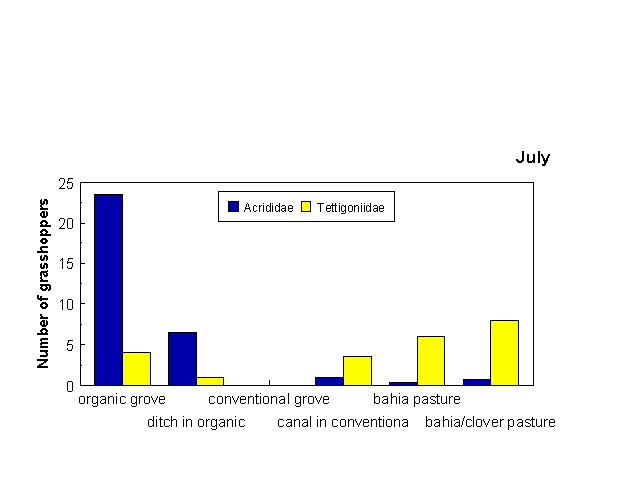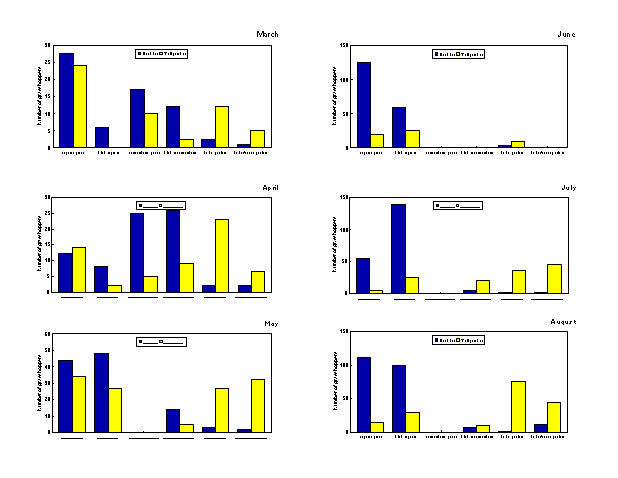
![]()
Back to 1995 Reports
1995 Annual Research and Extension Report
Terrestrial
Invertebrate Herbivores: Grasshoppers and Land / Resource Use
John Capinera
Department of Entomology & Nematology
OBJECTIVES
1. Qualitatively and quantitatively characterize the assemblage of grasshopper species associated with the agroecosystems found at the Buck Island site, and their spatio-temporal relationships.
2. Associate grasshopper species with plant resources and other habitat characteristics.
3. Determine the use of these dominant terrestrial herbivores as a food resource by avian or other vertebrate predators, and the influence of habitat on use of this resource.
BACKGROUND
Grasshoppers are the dominant terrestrial insect at the Buck Island research location. They are unlikely to be abundant enough to affect the quality or quantity of vegetation under the moist conditions of this site. However, they are likely a rich food resource for vertebrates, particularly avifauna. Initially we concentrated on qualitative survey of various sites , in an attempt to characterize fully the potential grasshopper assemblage. During the last 2 years, we have expanded the scope of activity to include quantitative estimates in the dominant agroecosystems, cattle pastures and citrus groves, as well as nearby disturbed, heterogeneous ditch bank floral communities.
METHODOLOGY
During late 1991 and throughout 1992 we conducted qualitative surveys of the Buck Island property and adjacent areas. This was used to define the potential species assemblage.
During 1993 and 1994 we attempted to make quantitative surveys monthly during the summer, as well as to maintain and update the species list. Quantitative estimates were made by tabulating the numbers of each species collected at each site from six 3-minute sweeps using a standard 15 in. sweep net. Many grasshoppers are not identifiable as immatures, so they were returned to the laboratory and reared to the adult stage
.
Six sites were selected for long-term monitoring:
1. two citrus groves, one having minimal disturbance and chemical input (hereafter termed "organic"), and one conventional grove located immediately adjacent to the Buck Island property;
2. irrigation ditches located immediately adjacent to each of the aforementioned groves; and
3. two bahia grass pastures (one nominally contained clover, but this was not evident) used for cattle grazing.
ACCOMPLISHMENTS
The grasshopper species assemblage has been fairly well
defined, although we continue to find new species occasionally in the study
sites, and undoubtedly there are additional species to be found in some of
the more natural habitats. There is ample evidence that land use patterns,
and the effects of land use on floral resource availability, profoundly
affect the abundance and nature of grasshoppers. This presumably affects
availability of grasshoppers as food for vertebrates, but the use of these
resources by insectivores is largely unproven. The most obvious
characteristics of the grasshopper assemblage are:
1. Acridid grasshoppers predominate in groves or other areas where a heterogeneous/disturbed plant assemblage exists.
2. Tettigoniids predominate in the homogeneous bahia grass pastures.
3. Grasshoppers are more abundant and more diverse in groves and disturbed environments.
4. Use of insecticides and herbicides disrupts and diminishes grasshopper numbers.
FUTURE PLANS
The present studies will terminate at the end of this
calendar year. There are two types of additional studies that could be
conducted, depending on the availability of funding:
1. If differential grazing is established in some sort of
replicated experimental design, then it would be of interest to examine
the effects of cattle grazing on the dominant terrestrial invertebrate
assemblage, namely grasshoppers. 2. If funds are available for intensive research, then it
would be desirable to examine the relationship of grasshoppers and avian
predators. Specific questions that could be asked include: - what birds forage on grasshoppers - are grove environments suitable for avian foraging of
grasshoppers - are the birds foraging in groves different than those
foraging grasslands - how far will grasshoppers fly to forage on grasshoppers - do birds significantly depress abundance of grasshoppers - does abundance of grasshoppers affect breeding success
of birds - can grove management be modified to allow economic
citrus production and still - allow abundant insect (grasshopper) life - is there a significant interaction of cattle, birds and
grasshoppers
95-96 Funds request: 1. Funds requested to continue with the current research is $0, because the present study can be completed by the end of this year.
2. If there is interest in funding a pasture management -insect herbivore interaction study, this could be conducted with the present level of funding, $5000.
3. An expanded research project directed at avian predation of grasshoppers would require a graduate student, fencing, and travel expenses totaling about $23,000.
Buck Island Ranch Grasshopper Species Inventory
Acrididae
Crytacanthacridinae
Aptenopedes sphenarioides Scudder
Melanoplus propinquus Scudder
Melanoplus sp.1
Opshomala vitreipennis (Marschall)
Paroxya atlantica Scudder
P. clavuliger (Serville)
Schistocerca americana (Drury)
S. obscura (Fabricius)
Gomphocerinae
Amblytropidia mysteca (Saussure)
Dichromorpha elegans (Morse)
D. viridis (Scudder)
Orphulella pelidna (Burmeister)
Oedipodinae
Chortophaga australior (Rehn and Hebard)
Tettigoniidae
Phaneropterina Amblycorypha floridana Rehn and Hebard
Conocephalinae
Conocephalus fasciatus (DeGeer)
Orchelimum agile (DeGeer)


The author can be reached at:
Dr. John Capinera
Tel: (904) 392-1901 ext. 115
Fax: (904) 392-0190
e-mail:entnem@gnv.ifas.ufl.edu
2001 Southern DataStream